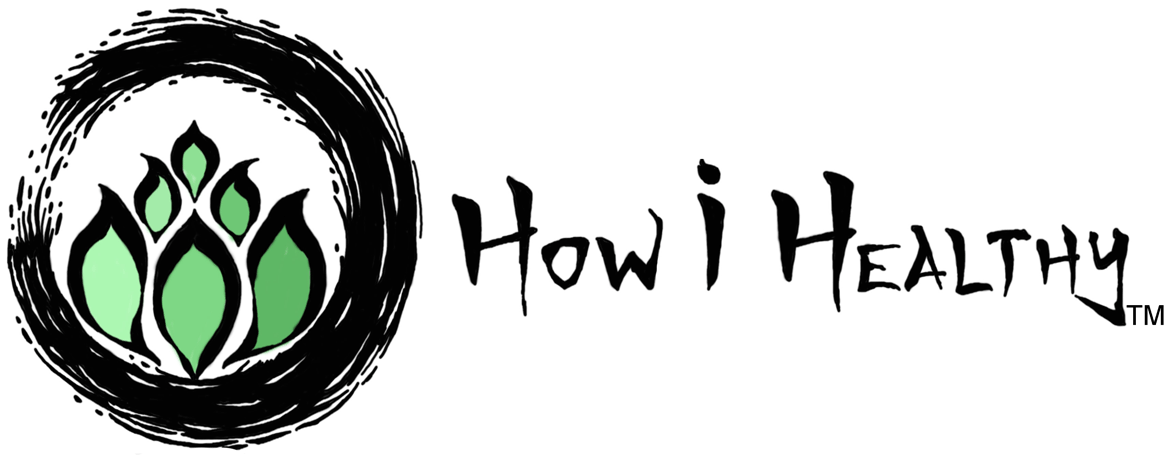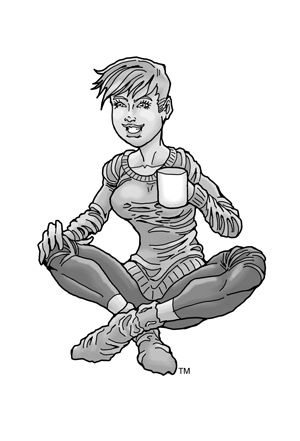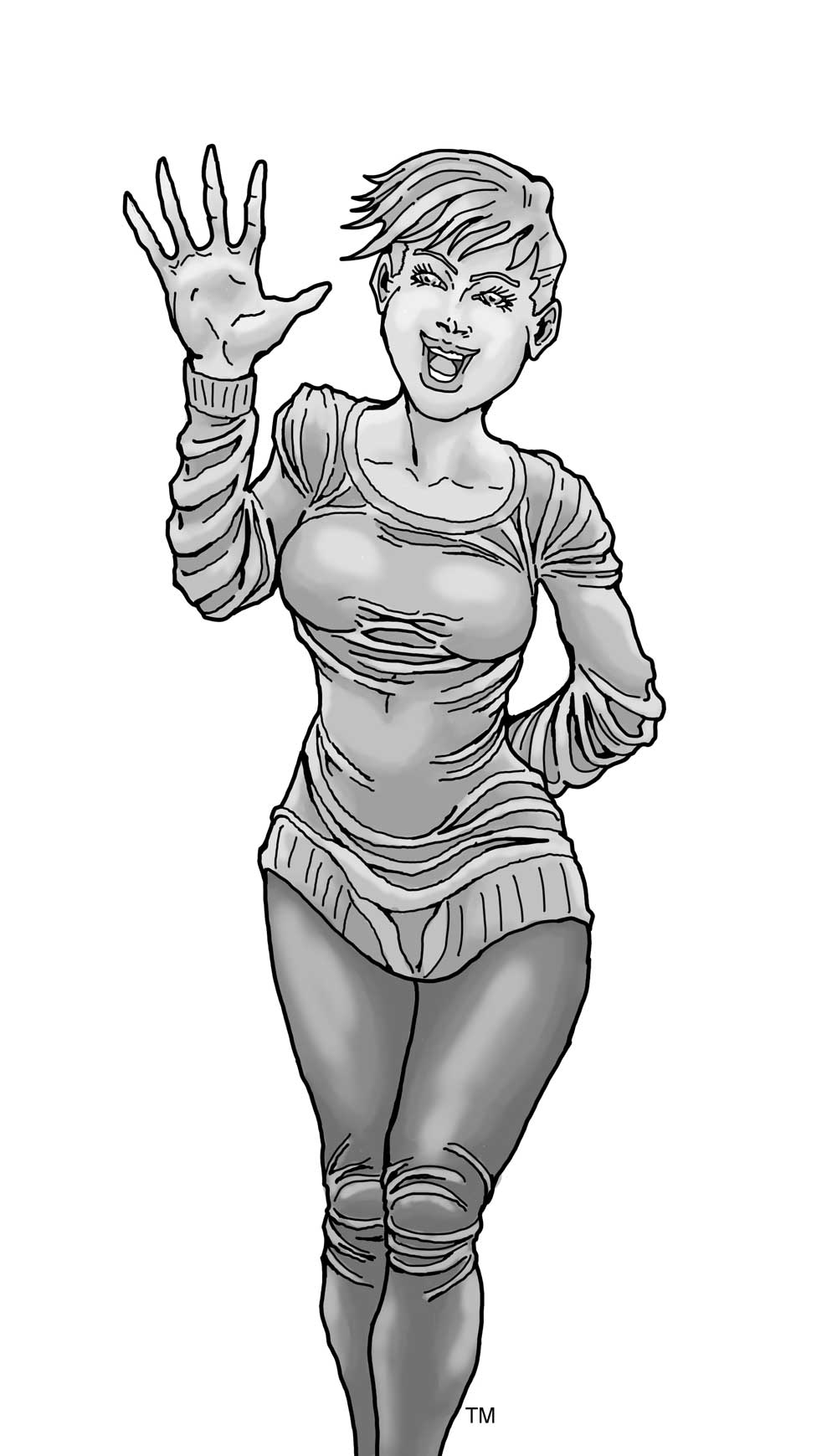In This Article, We'll Cover:
- Mattress & Bed History
- The Social Evolution of the Twin Bed
- Today’s Mattress Problems
- Greenwashing in the Mattress Industry
- Eco-Certifications to Look For
- How i Healthy’s Favorite Organic Mattress & Why
We spend 1/3 of our life in bed. What we sleep on matters. Both for our health and our planet.
Most conventional beds are petroleum-derived polyurethane foam. Nonrenewable, nonbiodegradable, and poorly recycled. (34, 60)
Plus, they’re coated in flame-retardants. (43, 44, 45, 46, 47, 48)
And release toxic VOCs right into our bodies. (49, 50, 51, 52, 53, 54, 55, 56, 57)
But there are better options out there.
But first, let’s talk history & science. Because knowledge!
Random Bed Facts
1. “Mattress” has Arabic Roots
Etymology:
Middle-English: matera, from Medieval Latin: materacium, from Arabic: maṭraḥ, meaning “place where something is thrown”. (24)
2. Heated Beds in 4th Century Asia
Roman heated floors, or hypocaust, often seen in bathhouses weren’t the first radiant heat system. (25)
Thousands of years earlier, folks in northern China and Korea warmed floors via dikangs (Chinese: “heated floor”) or ondol (Korean: “warmed stone”). (25, 26)
These heat systems utilized raised platforms, a fire source, and a series of flumes. This system drew heat under the platforms and out a chimney. Stones placed above the flumes captured heat that radiated to the floor above. Laying a futon on these floors made for cozy warm beds. (25, 26)
3. Bugs? Try a Cast Iron Bed!
Cast iron bed frames in the mid-18th century replaced wooden ones.
Wood, porous and crack-filled, was a heaven for bed bugs, fleas, and lice. Cast iron eliminated this issue and made treating infested bed frames more effective. Alcohol or kerosene could even be poured between the joints of the frame and set ablaze. (27, 28, 30)
4. Twin Beds: From Sanitation to Stigmatization
Disclosure: I find the history of twin beds fascinating. Buckle up!
Europeans in the Middle Ages often slept in communal beds. Parents, children, relatives, and visitors often co-slept. Sharing a single bed was practical. It kept folks warmer, used less linens, and cost less. (35)
By the 1880s, Victorian sanitation reform was in full swing. Public health infrastructure, medical hygiene, and disease control swept through Britain. (30)
Dr. Benjamin Ward Richardson took this to the domestic level.
He popularized the idea that bedrooms, where folks spend 1/3 of their life, are vitally important to keep clean. And what more important than the bed on which a person sleeps? (30)
For Dr. Richardson, sleeping in twin beds, rather than shared, was sanitary reform. Twin beds became the “cleaner way” to sleep. (30)
But twin beds were often only an option for the wealthy. The upper class could afford separate beds, sets of linens, and had the rooms/space to accommodate them. (35)
Twin beds became a status symbol, not health reform. And from there, opinions and stigmas went to several directions:
- Some “marriage manuals” emphasized the importance of sleeping separate for martial success.
- Others claimed twin beds signaled sexual dysfunction and a doomed marriage. Some folks even blamed twin beds for the rising divorce rates in the 1950s.
- Some mid-1900s feminists argued that twin beds empowered people. No longer were folks doomed to sleepless nights caused by blanket stealing, snoring, or lack of space.
- And yet, other feminists claimed twin beds were sexual repression.
(30)
Jump to today. Twin beds still face many of the same stigmas.
Stigmas like:
- “sleeping apart = falling apart”
- “no shared bed = no sex life”
The pressure for folks to sleep together is on. Even while surveys show that some folks prefer to sleep apart.
1 in 10 respondents say they already sleep separate, according to a survey from The Sleep Better Council. And 2 in 10 respondents said their dream home had two separate master bedrooms. (36)
There are many reasons why folks might prefer to sleep separate, here’s a few:
- Because they want to.
- Improved sleep quality while sleeping apart.
- Sleep habits or sleep schedule.
- Medical reasons: sleep apnea, Restless legs syndrome (RLS), PTSD, or urinary/bowel conditions.
- Sleep talking, snoring, or moving frequently.
- Mattress or temperature preferences.
(35)
And the results of separate sleeping? Often better sleep. (37)
Co-sleeping adults experience more sleep disturbances while sharing their bed than when alone. Despite this, most people still prefer to sleep with their partner(s). Even when presented the evidence that solo-sleep improves sleep outcomes. (37, 38)
It appears that bed sharing is socially constructed, no science based. We do it because we think we should, or because we want to, not because evidence says it’s the better way to sleep. Rather the opposite.
So, why do folks choose to sleep with their partner(s) at the expense of sleep quality?
There isn’t a study (yet!) saying why, but anecdotally I’d say for me: 1. I feel safer with my partner beside me and 2. The social stigma of sleeping apart. But that’s just me.
Conclusion of this rabbit hole:
The twin bed’s origin story is rooted in health & hygiene, not sexual repression or bad relationships.
But that’s often forgotten. Even today.
Many folks sacrifice a good night’s sleep in fear that sleeping apart dooms a relationship.
If you are looking to explore different sleeping options with your partner(s), Sharing the Covers: Every Couple’s Guide to Better Sleep is an excellent resource by sleep expert and psychologist Dr. Wendy Troxel. It’s a workbook full of judgment-free questionnaires, checklists, and activities that guide sleep conversations so you and your partner(s) can sleep in a way that works for you all. However that looks. Together or apart.
The Modern Bed
We spend 1/3 of our lives on a bed. So what we sleep on matters.
Plus, there’s the environmental impact to consider.
Turns out, mattresses have a big impact. For our bodies and the Earth.
Bad for the Earth & Body
Today’s mattresses, toppers, and pillows are often made from polyurethane foam.
Polyurethane foam is petroleum- derived, nonrenewable, nonbiodegradable, and poorly recycled. Most polyurethane foams end up in landfills or are incinerated. Both of which release harmful emissions. (34, 60)
So, end-of-life for polyurethane foam isn’t so great for the Earth. What about start-of-life? Well, manufacturing isn’t so great either.
Making polyurethane foam requires two reactants (a isocyanate & polyol) mixed with water. First there’s a polymerization (of those reactants) and then expansion (with water). (34, 60)
More simply, two ingredients plus some water and boom! Polyurethane foam.
Seems harmless enough, But what are those ingredients?
It varies depending on the desired rigidity of the foam.
Typically, 4,4-Methylenediphenyl Diisocyanate (MDI) and 2,4-Toluene diisocyanate (TDI). Both known to emit VOCs and cause health issues. (58, 59)
Back in 1997, the Agency for Toxic Substances and Disease Registry closed a North Carolina polyurethane foam plant due to plant TDI emissions. Not only were plant workers harmed, the off-site air exceeded safe levels for TDI too. This caused nearby residents an array of health complications as well. (57)
So, the manufacturing processes emits VOCs into environment.
Bonus? VOCs can linger on the final mattress product too.
For months.
This lingering is called “off-gassing”. And that mattress off-gasses right into our noses as we’re sleeping. That said, experts say the impact of VOCs are more harmful to infants and children than to adults. (55, 56)
VOC exposure links to headaches, blood disorders, confusion, balance difficulties, breathing problems, impaired neurological functioning, reproductive problems, coma, central nervous system damage, liver damage, tumors, cancer, and death. (49, 50, 51, 52, 53, 54, 55)
And, since polyurethane foam is basically solid gasoline, it’s highly flammable.
To meet flame-resistant standards, mattresses are dosed in chemical flame-retardant treatments. (45, 60)
Yep. Things just got worse.
Flame-retardants go by many names.
Like: TRIS, Polybrominated diphenyl ethers, Brominated phthalate fire retardants, Chlorinated phosphate fire retardants, TDCPP, and BFRs. (42)
There are over 175 different kinds of flame retardants. (42)
And those flame-retardants end up in our bodies. Flame-retardants are detectable in urine, placentas, and breast milk. (45, 46, 47, 48)
Flame-retardants link to decreased fertility, sperm count, altered hormone levels, and neurotoxicity. (43, 44)
Conventional mattresses are terrible for people and planet.
It goes like this:
- Polyurethane foam manufacturing harms the environment, plant workers, and nearby residents.
- Even with that sacrifice, foam doesn’t meet flammability standards. So it needs chemical treatments.
- Those chemical treatments also wreak havoc on our health.
- Plus, that foam off-gasses harmful VOCs too.
- And if that’s not enough, that mattress doesn’t biodegrade or get recycled often. It’ll probably sit in a landfill or be incinerated, releasing even more harmful pollutants into the air.
(42, 44, 45, 46, 47, 48)
Better Organic Mattress Options: Wool
But there’s a naturally flame-resistant fiber out there! It biodegrades, supports family farms & local industry, is renewable & sustainable, and doesn’t emit VOCs.
I’m talking about wool!
Wool is magical. Here’s why
- Naturally flame-resistant. Wool mattresses pass flammability standards without any chemicals.
- Wool biodegrades in both soil and water.
- Thermoregulates. Stay warmer when you’re cold, and cooler when you’re hot.
- Naturally odor resistant. Because wool can pull moisture, like sweat, away from the body and into the air, wool reduces odors too. Seriously. I wear wool underwear, and it never smells bad.
- Wools waxy coating inhibits mold, mildew, bacteria growth, and is naturally water repellent.
- Organic wool requires minimal processing. Once shorn, wool needs just a mild bath, carding, combing, and needling, before its ready to go. But be careful. Many non-organic wool processes use harmful chemicals both during processing and product manufacturing.
(16, 62, 63)
Wool mattresses are often paired with latex cores or pillow toppers.
Better Organic Mattress Options: Latex
Latex is a sticky milky fluid found in about 10% of all flowering plants, including rubber trees (Hevea Brasiliensis). Latex’s prime function is thought to aid against herbivorous insects. (64)
Because of its consistency, latex can be molded into pretty much any shape with different densities and thicknesses. Once baked, latex holds that shape, making it extremely versatile.
So, how is a latex mattress made?
Like maple syrup from maple trees, latex is tapped from rubber trees by local farmers. No polluting machines and no tree clear-cutting required. That means protected animal habitats and forests. And forests mean less carbon dioxide in the air. Plus, organic untreated latex is biodegradable. Boom. (65, 66)
Most trees are tapped 4-6 hours a day, 2-3 times a week, for 25 years. (65)
Next, the raw latex is mixed in a centrifuge, this removes impurities. Once cleaned, the latex is poured into molds. Those molds bake at 350 degrees Fahrenheit. Once cooked, the latex gets a quick bath and blow dry. (65)
That’s it! Collect, spin-until-clean, pour, and bake! The latex is ready for mattress making.
Then wrap that beautiful wool/latex bed with an organic cotton cover and we’re set. Organic cotton means better worker rights and less environmental impact. Win win! (16, 61)
So, wool, latex, and cotton make a great mattress. Now that you know what to look for, how do you know what you’re getting?
Certification Marks: Material Sourcing
I’ve seen “plant-based foam”, “All natural”, and “Toxic-free!” mattresses out there.
Ug. These claims mean nothing.
And, if you’ve seen my Guide to Greenwashing, then you know that product claims without proof don’t impress me. They infuriate me.
The solution to deceptive greenwashing? Certification marks and third-party testing!
Let’s dive into the certification marks you might find on a mattress.
Eco Wool®

This mark means wool, from pasture to product, meets high standards.
Standards like: sustainable grazing methods, maintaining predator eco-systems, and prohibiting herbicide/pesticide. (39)
Eco-Wool® also opposes mulesing and “dipping” a process where sheep are bathed in a pesticide solution. (39)
Once sheared, wool cannot be bleached, carbonized (strong acids that strip wool and ruin its texture), and crimping (a perm-like solution that recreates the coils of wool that carbonization destroyed). (39)
Global Organic Textile Standard (GOTS)®
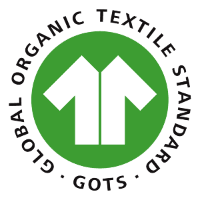
This mark can appear on clothing, bedding, or mattresses.
To qualify, textiles must be at least 70% organic, contain no flame retardants, endocrine disruptors, GMOs, heavy metals, formaldehyde, or chlorination. (16)
GOTS® requires environmental and social standards too. Forced and child labor are banned. Workers have union rights, voluntary overtime, fair pay, safe working conditions, clean toilet facilities, and portable water. (16)
GOLS-Global Organic Latex Standard
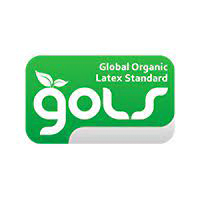
Not only does this mark ensure that you’re actually buying latex and not some polyurethane foam phony, but it also means that latex was harvested & produced sustainably. And by workers treated fairly. (40)
Responsible Wool Standard (RWS)®
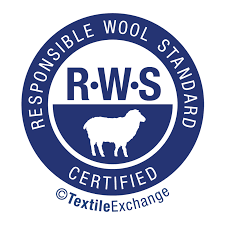
A voluntary standard farms can commit to. These standards ensure the farmland, biodiversity, native species, soil, and sheep are treated responsibly. It details standards for wool production and animal care. The standard requires shelter, shade, and windbreaks on pastures to protect sheep from adverse weather conditions. It prohibits dehorning, disbudding (or the removal of horn buds in young animals), substantial horn trimming, and tail docking unless animal welfare is at risk. (22,23)
Mulesing, or the practice of removing chunks of wool-bearing skin from a sheep’s rear end to keep the area clear, is prohibited. (22, 33)
Fertilizers and pesticides can be used “minimally.” (22)
Vegan
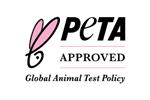
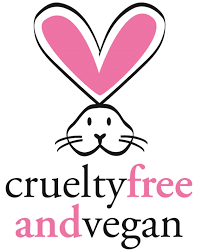
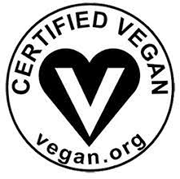
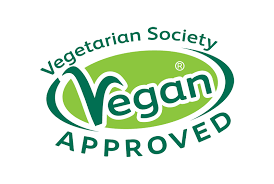
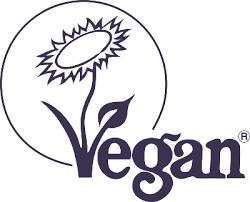

If vegan is your jam, these are the marks for you!
Wool tends to be the go-to material for mattresses because of its natural flame resistance. No chemicals needed.
But if you’re looking for vegan mattresses, or are allergic to wool, wool isn’t going to cut it.
A mattress with one of these marks means wool-free. These mattresses are often made from cotton and latex. But without wool, it isn’t naturally flame resistant.
But you might not want flame retardant chemicals linked to health problems sprayed all over your vegan mattress.
Avocado®’s Vegan Collection, uses graphite for flame protection instead of flame retardants. Their vegan mattresses are wool-free, chemical-free, and meet all mattress flame-resistant requirements. A great option for folks!
Certification Marks: Material Testing
We’ve covered certifications that verify the integrity of materials.
Now let’s talk about certifications that verify the safety of those materials.
We’ll start with one mark that means absolutely nothing. CertiPUR-US®.
If I see this mark on something I actively avoid it.
CertiPUR-US®
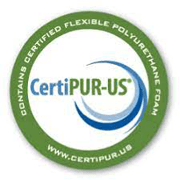
This mark appears on “Low VOC” and “Non-Toxic” furniture like mattresses and sofas.
Don’t be fooled. This is greenwashing.
CertiPUR-US® is registered to the Alliance for Flexible Polyurethane Foam.
That’s right, the producers of foam certify the foam too. The foam industry established the standard and testing requirements. This vested interest raises red flags. It opens the way for biased practices and putting profits before safety.
And things only get worse.
CertiPUR-US® uses Greenwashing Tactics often. Their favorite greenwashing tactic?
Misdirection and irrelevant claims.
“Misdirection” means highlighting one attribute to hide/excuse another. (32)
“Irrelevant Claims” often means saying something is “free from” when it’s already banned by a governing body.
Here’s a sampling of CertiPUR-US® misdirection and irrelevant claims:
- “Made without PBDEs, TDCPP, or TCEP (“Tris”) flame retardants” (33)
- Spoilers: The EPA already bans these. So, the claim is irrelevant. (12)
- Bonus! While these three flame-retardants are not present, there are hundreds more that could be (13). So, this claim is also a misdirection tactic. Two-for-one deal!
- “Made without mercury, lead, and other heavy metals” (33)
- Heavy metals are “not common components of foam chemistry” and unlikely present in mattresses to begin with, even according to CertiPUR-US®. (14)
- “Made without formaldehyde” (33)
- Formaldehyde has “never been used as a raw material in foam” and are also unlikely present in mattresses to begin with, according to CertiPUR-US®. (14)
- “Made without phthalates as regulated by the Consumer Product Safety Commission” (33)
- The Consumer Product Safety Improvement Act “eliminated the use of eight specific phthalates for use in children’s toys and child care items”, according to CertiPUR-US®. (14, 31)
- This means that only eight phthalates are not permitted in CertiPUR-US® certified foams. But there are dozens of other phthalates that can be. (15)
- “Low VOC (Volatile Organic Compound), less than 0.5 parts per million”. (14, 33)
- This has real value. But “low emission” is not the same as “zero emissions”. So, no thank you.
And, for the final point: CertiPUR-US® is for polyurethane foam mattresses.
We’ve already talked about the Petroleum- derived, nonrenewable, nonbiodegradable, and poorly recycled material that polyurethane is. (34)
That said, material scientists and chemical engineers are trying to address this sustainability issue. Calls for recyclability and bio-based foams look promising, but we shall see.
Long story short: CertiPUR-US® means misleading and petroleum-filled mattresses. This is a mark I avoid.
Greenguard Gold®
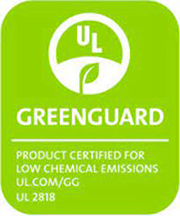
Now for the lab-tested certifications that actually mean something!
This mark, by UL Environment®, applies to products like furniture, insulation, mattresses, and paint.
This seal means the product has passed VOC emissions testing. Test results determine Greenguard® or Greenguard Gold®. (17)
VOCs, or Volatile Organic Compounds, are “gasses emitted from certain solids or liquids.” VOCs are linked to health problems and complications. (17, 18, 19).
Folks spent about 1/3 of their life face-first in a mattress. So what that mattress off-gasses is likely inhaled.
Greenguard Gold® certification helps us rest easy.
eco-INSTITUT Standard
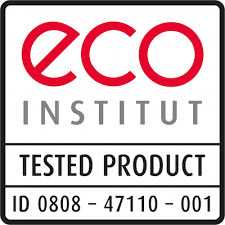
Based in Cologne, Germany, this lab tests products for 90 substances including.
These include VOCs, pollutants, heavy metals, pesticides, phthalates, formaldehyde, acetaldehyde, triclosan, flame-retardants and more! (41)
Made Safe®
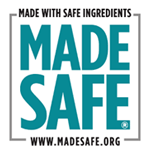
Products with this mark passed testing to ensure that nearly 100 contaminates are not present. Contaminates like heavy metals, neurotoxins, VOCs, reproductive toxins, carcinogens, flame retardants, endocrine disruptors, behavioral toxins, toxic solvents, or high-risk pesticides. (18)
Oeko-Tex®

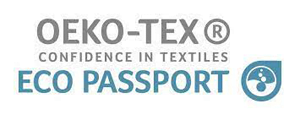


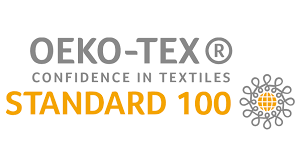

Oeko-Tex® has several marks. Oeko-Tex® comprises of 18 independent research and test institutes from around the world.
Primarily these certifications focus on product testing, ensuring they do not contain any of the 100 chemicals prohibited in their standards. (20, 21)
“Made in Green®,” “STeP®,” “Detox to Zero®” and “Eco Passport®” marks do not test a product’s environmental or social impact. (20, 21,)
My Favorite Mattress
There we have it! The marks I looked for when natural mattress shopping.
What else did I consider? My regular go-to standards that I try to meet:

The How i Healthy Standard
Our favorite products/brands meet as many of these conditions as possible.
Healthy body, healthy planet, & healthy sex means:
- Align with My Best Sustainability & Ethical Tips
- As Local as Possible
- Cruelty-Free
- Doesn’t Contain these Harmful Chemicals
- Environmental and/or Socially Responsible Company
- Ethically Made: Fair Trade, Living Wages, Safe Worker Conditions
- Gender-inclusive
- No Greenwashing Scams
- Organic & Sustainably Harvested Ingredients
- Pass How i Healthy’s Counterfeit Vetting Process
- Purchased Through/From an Ethical Shop/Marketplace.
- Zero Waste / Plastic & Bioplastic-free / Home Compostable
- 1% for the Planet®, B Corporation®, Green American Business®, or similar credentials
And there are a few awesome companies making awesome bedding. Let’s dive in.
Mattress & Pillows: Avocado®
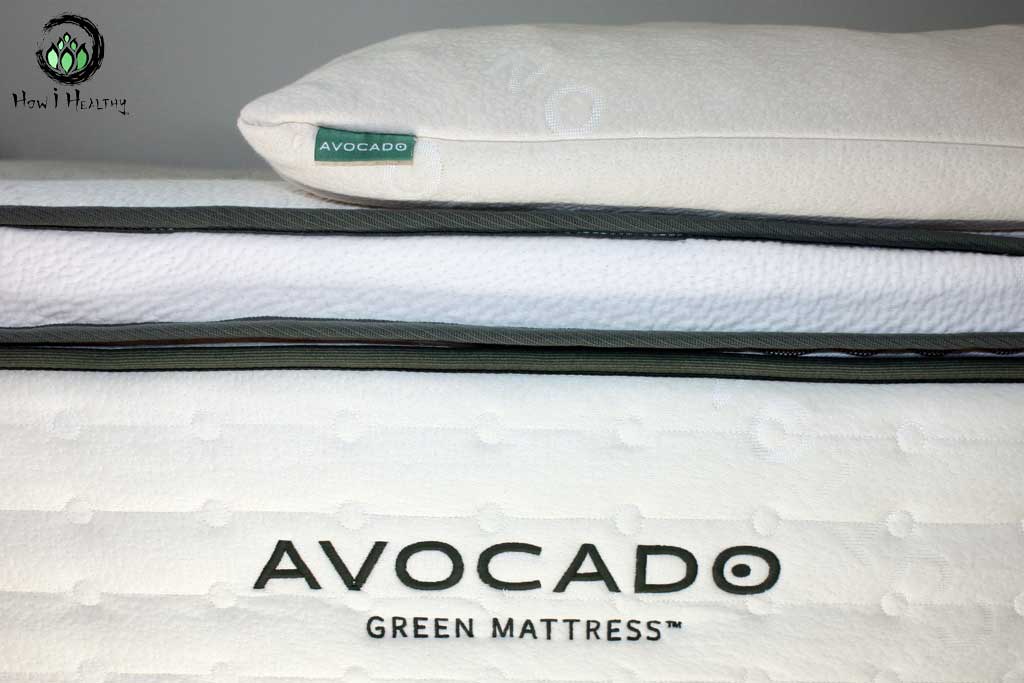
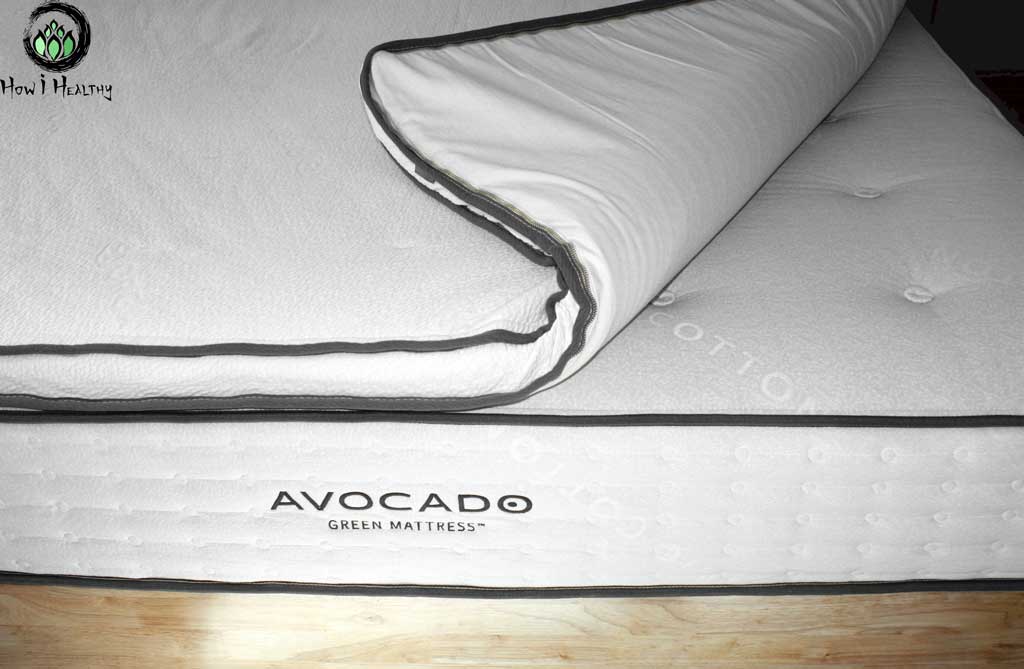


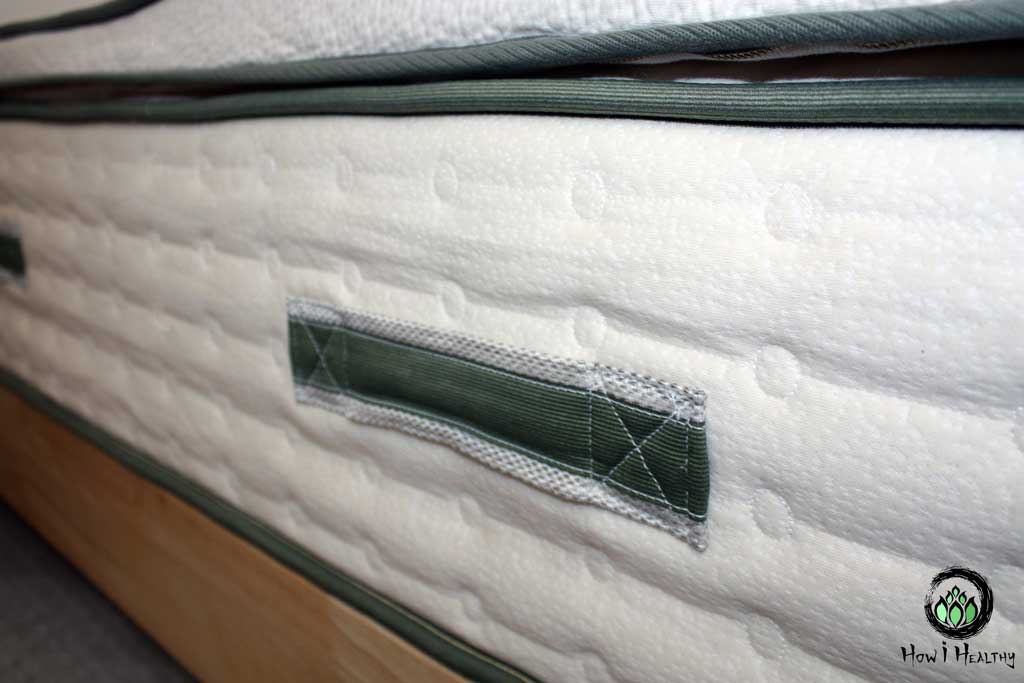

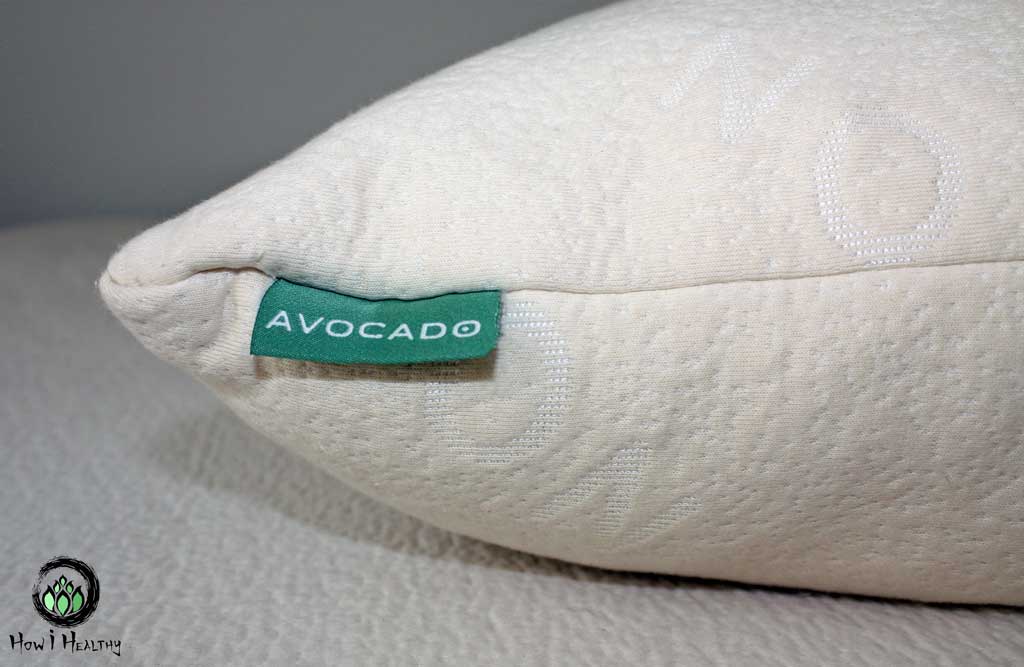


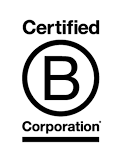
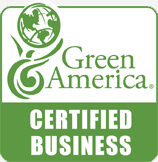
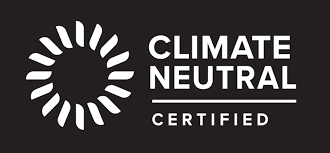







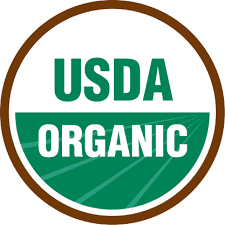
Product Kudos
Origin: Handcrafted in Los Angeles, California with ethically sourced and third-party tested materials from the Himachal Pradesh region of northern India.
End of Life: Depends on the mattress. In general: Wool, latex, and cotton components are biodegradable and reusable at proper facilities. Inner steel coils can be scrapped and repurposed. There is a fully compostable mattress too.
Ingredients/Packaging:
- Avocado® Mattress Collection: Most feature, Latex*, Wool*, Cotton*, and Steel Coils. Mattresses are vacuum sealed in a polyethylene plastic wrap. Avocado® is developing a compostable wrap to replace the plastic wrap.
(*Certified organic & ethically sourced product)
Why It’s Awesome:
- Carbon negative shipping and production.
- Chemical flame retardant-free. Instead, 100% Responsible Wool Standard® certified wool meets flame resistant requirements.
- Heavy duty handles sewn into the mattress make moving the mattress easy.
- List of certificates and testing results online. SO many!
- No petrochemical foams or petroleum-based polyurethane.
- Pillows have an adjustable filling or different firmness of latex. Customize to your preference!
- Spring-Free 100% Latex Mattress is the next one I’m getting!
- So many Organic Bedding Options. And at different price points.
- The Latex Mattress Topper made our firm mattress perfect for us.
- Traditional mattress making techniques, like needle-tufting, means no toxic solvents or adhesives.
- Traditional & sustainable latex harvesting with the certifications to back it up.
Want vegan options? Avocado® has a whole Vegan Collection! The coolest part? They managed to create a chemical-free flame-retardant system using graphite. Whoa!
- 1-year money back guarantee & 25-year limited warranty.
Company Kudos
- ALL THE CERTIFICATIONS. Up and down the supply chain. Ethical, sustainable, organic, worker-first, you name it, Avocado® does it.
- Avocado® is developing a compostable wrap to replace the plastic wrap currently used to ship mattresses.
- Employs 100 famers & 400 herders with fair, living wages across 50 villages in the Himachal Pradesh region of northern India.
- “Farm to mattress”: Owns their own sheep pastures & 4,000 acres of latex rubber tree plantation. Owning the supply chain ensures sustainable and ethical practices.
- Handcrafted in Los Angeles, California with ethically sourced and third-party tested materials like wool and latex.
- Wind & solar powered business.
(1, 2, 3, 4, 5)
A Special Note
I bought my mattress, topper, and pillows from Avocado® almost 9 years ago. They only had one option then. There are several now!
Options are great, but my next mattress will be different from the one pictured above.
Why?
Because initially, I found the mattress comfortable, but since I’ve gotten older, I find I like softer mattresses.
When I reached out to Avocado® customer service, they kindly offered a discounted mattress topper to soften my bed. The topper helped tremendously, but it’s still not as soft a bed as I like.
Avocado® has mostly Medium/Firm options, but there are mattress/topper combos to maximize plushness.
The other thing? I find the coiled springs of the mattress transfer too much movement now that I sleep with a partner.
When my partner shifts, I feel it and wake up. That’s why our next mattress will be the Spring-Free 100% Latex Mattress. It’s biodegradable too!
My current & pictured mattress:
If I were shopping today, I’d go for the coil-free 100% latex option:
Also pictured: Avocado® pillows and a latex mattress topper!
But again, if I were shopping today, I’d go for:
The mattress I originally bought is still great and will make an excellent guest bed when it’s time to buy my next Avocado®.
It’s just that my body has changed, I like softer beds than when I was younger. So I will upgrade the softness level in my next bed.
And now that I have a partner, I’ve come to dislike coil/spring mattresses as they tend to transfer movement more.
I still love Avocado® though!
Bed Comforter/Duvet: Holy Lamb Organics®
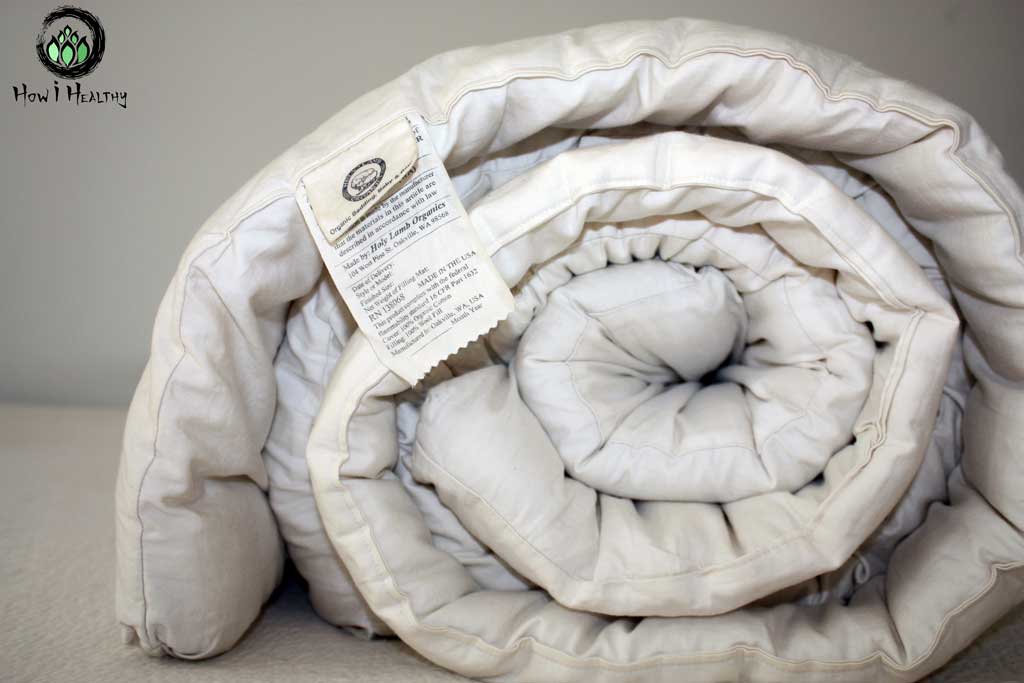


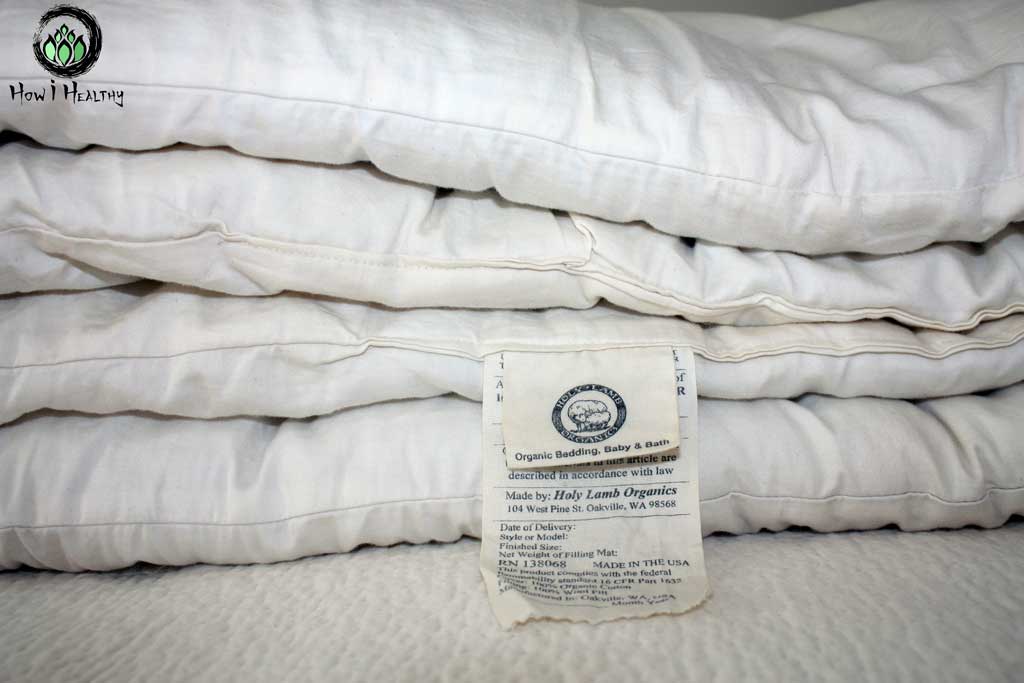

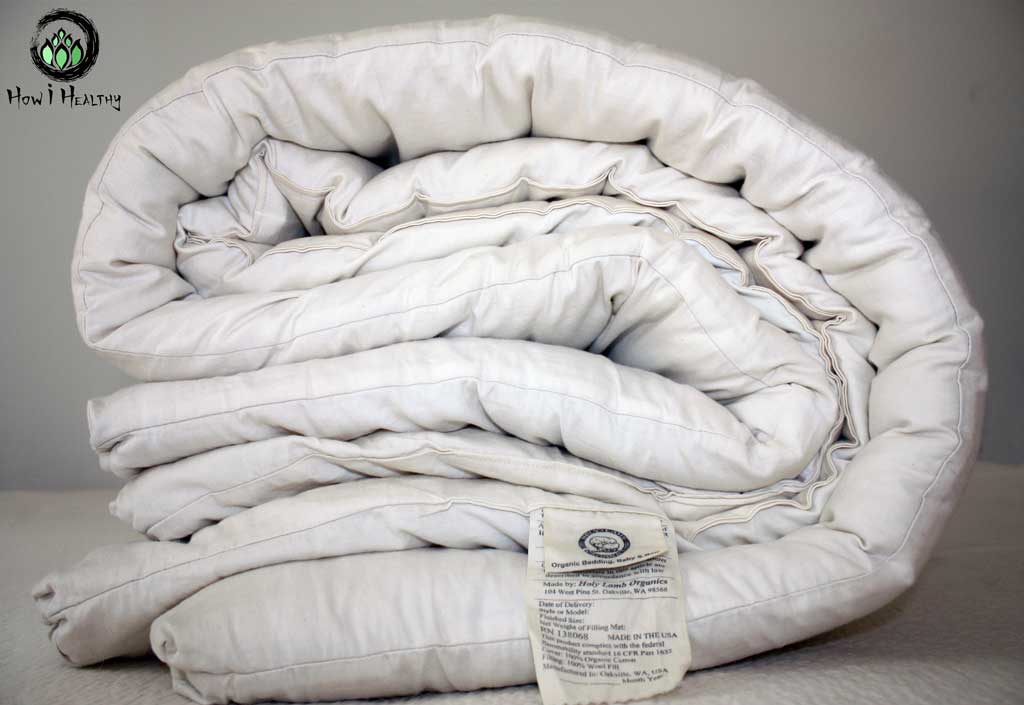


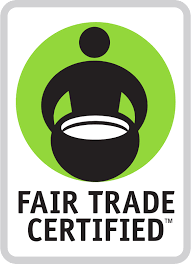





Product Kudos
Origin: Wool from Oregon and California sheep ranches, carded in Montague, California, then hand crafted in Oakville, Washington. Organic cotton from India.
End of Life: Biodegradable and/or reusable wool and cotton.
Ingredients/Packaging: Plastic-free & compostable packaging.
- Holy Lamb Organics Collection: Mattresses, bedding, pillows, sheets are wool and/or cotton.
Why It’s Awesome:
- All cotton used is Fair-Trade Certified.
- Cozy, warm, and never smells. Wool is amazing at regulating body temperature, resisting odors, and is incredibly durable. My Wool Comforter is so warm.
- Minimally processed wool. It’s simply sheared at American farms, washed in water and biodegradable wool soap, then carded at a local mill.
- This All Season Wool Comforter looks perfect for folks looking for multi-weather options.
- Wool and cotton and nothing else! It’s also third-party tested for heavy metals.
- Did I say cozy? Once I’m under this I don’t want to get out! It’s so snuggly!
Company Kudos
- American grown, raised, and made bedding & mattress options.
- Globally source materials are certified organic & ethical.
- Fragrance-free workplace, personal care products, cleaning products, and production. This ensures wool smells like wool and nothing else.
- Partners with local carding mill that supports local American family ranches.
- Plastic-free packaging for all out going products. In coming plastic from sources outside their control (like the wool batting bags from the mill) are returned to the mill and reused for future shipments.
- Offers a Clearance Collection of almost-perfect products at a slight discount. I purchased my discount comforter with a “small fabric defect”. Honestly, I still don’t know where the defect is, but it’s held up perfectly for 9+ years.
- Woman-owned and Green America® certified business.
(6, 7, 8, 9, 10)
The Takeaway Message












We spend a lot of time on our beds.
What our beds are made from matters. Not only for our health, but for the planet’s too.
Conventional foam mattresses, are often made from polyurethane foam.
Polyurethane foam is petroleum- derived, nonrenewable, nonbiodegradable, and poorly recycled. It’s production and end-of-life isn’t great for humans or the planet. And since it’s flammable, polyurethane mattresses need flame-retardants to pass flammability standards. (34, 60)
Memory foam is basically solid gasoline doused in flame-retardants.
And flame-retardants ain’t harmless. Flame-retardants link to decreased fertility and are detectable in urine, placentas, and breast milk. (43, 44, 45, 46, 47, 48)
Let’s add in VOCs to this mess.
Polyurethane foam production releases VOCs into the environment. And after production? Foam mattress “off-gas”. Right into our noses. For months. (55, 56, 57)
VOC exposure links to many nervous system disorders, blood disorders, breathing problems, reproductive problems, liver damage, tumors, cancer, and death. (49, 50, 51, 52, 53, 54, 55)
But don’t despair!
Two natural & organic mattress companies are putting people and planet first.
Avocado® and Holy Lamb Organics®.
And if you are a weighted blanket person, here’s a great plastic & polyester-free Weighted Blanket!
Both make organic mattresses, bedding, and pillows from ethical & sustainable sources.
I have wonderful products from both companies. My natural mattress, topper, and pillow are from Avocado®. My comforter and some other pillows are from Holy Lamb Organics®.
Both companies are fantastic, it’s really down to what you’re looking for.
Avocado® does have vegan options, if that’s your jam.
However, you like to sleep, these companies got you covered!
That’s How i Healthy!
-Artemis
- “Our Organic Wool Farm: Avocado Green Mattress®.” Avocado Green Mattress, https://www.avocadogreenmattress.com/pages/organic-wool-mattress.
- “Environmental Sustainability Report 2020: Avocado Green Mattress®.” Avocado Green Mattress, 2020, https://www.avocadogreenmattress.com/pages/2020-impact-report.
- “Eco-Friendly Mattresses: Certified Organic: AVOCADO GREEN MATTRESS®.” Avocado Green Mattress, https://www.avocadogreenmattress.com/pages/eco-friendly-mattress.
- “Committed to 1% for the Planet: Avocado Green Mattress®.” Avocado Green Mattress, https://www.avocadogreenmattress.com/pages/1-percent-for-the-planet.
- “100% Gots & GOLS Certified Mattresses: Avocado Green Mattress®.” Avocado Green Mattress, https://www.avocadogreenmattress.com/pages/certifications.
- “Our Wool Mill & Trusted Partner.” Holy Lamb Organics, https://www.holylamborganics.com/pages/our-wool-mill.
- “Cotton, Wool, Latex.” Holy Lamb Organics, https://www.holylamborganics.com/pages/cotton-wool-latex.
- “Certifications and Testing.” Holy Lamb Organics, https://www.holylamborganics.com/pages/certifications.
- “Zero Waste and Keeping Plastic out of the Loop.” Holy Lamb Organics, 29 Mar. 2019, https://www.holylamborganics.com/blogs/news/117218885-plastic-free-zero-waste-managing-our-model.
- “Our Choice to Be a Fragrance-Free Company.” Holy Lamb Organics, 18 Mar. 2016, https://www.holylamborganics.com/blogs/news/59079109-about-our-choice-to-be-a-fragrance-free-company.
- “The Montreal Protocol on Substances That Deplete the Ozone Layer – United States Department of State.” S. Department of State, U.S. Department of State, 2019, www.state.gov/key-topics-office-of-environmental-quality-and-transboundary-issues/the-montreal-protocol-on-substances-that-deplete-the-ozone-layer/
- “Polybrominated Diphenyl Ethers (PBDEs).” EPA, Environmental Protection Agency, 22 June 2017, epa.gov/assessing-and-managing-chemicals-under-tsca/polybrominated-diphenyl-ethers-pbdes
- “Flame Retardants.” National Institute of Environmental Health Sciences, U.S. Department of Health and Human Services, 2020, niehs.nih.gov/health/topics/agents/flame_retardants/index.cfm
- “CentriPUR-US Newsletter.” Hangtag Flyer, 2016, certipur.us/wp-content/uploads/2016/04/hangtag-flyer.pdf.
- National Center for Biotechnology Information. “PubChem Compound Summary for CID 181977, Phthalate” PubChem, https://pubchem.ncbi.nlm.nih.gov/compound/Phthalate. Accessed 31 January, 2023.
- “GOTS Standard.” Version 5.0, 2017, www.global-standard.org/images/GOTS_Documents/GOTS_Standard_5.0_EN.pdf.
- “UL GREENGUARD Certification Program.” UL, 2020, www.ul.com/resources/ul-greenguard-certification-program.
- “Hazard List of Chemicals, Materials & Ingredients.” MADE SAFE, 2020, madesafe.org/science/hazard-list/
- “Volatile Organic Compounds’ Impact on Indoor Air Quality.” EPA, Environmental Protection Agency, 6 Nov. 2017, epa.gov/indoor-air-quality-iaq/volatile-organic-compounds-impact-indoor-air-quality
- “OEKO-TEX® Standards at a Glance.” OEKO-TEX® , 2020, www.oeko-tex.com/en/apply-here.
- “Locations of OEKO-TEX.” International Association for Research and Testing in the Field of Textile and Leather Ecology (OEKO-TEX®), 2020, www.oeko-tex.com/en/about-us/oeko-tex-worldwide.
- “Responsible Wool Standard.” Textile Exchange, 2016, responsiblewool.org/wp-content/uploads/2016/06/RWS-standard.pdf.
- “Mulesing by the Wool Industry.” PETA, 22 June 2010, peta.org/issues/animals-used-for-clothing/wool-industry/mulesing/
- “Mattress Definition & Meaning.” Merriam-Webster, https://www.merriam-webster.com/dictionary/mattress
- Zhuang, Zhi, et al. “Chinese Kang as a Domestic Heating System in Rural Northern China—a Review.” Energy and Buildings, vol. 41, no. 1, 2009, pp. 111–119., https://doi.org/10.1016/j.enbuild.2008.07.013. https://www.sciencedirect.com/science/article/abs/pii/S037877880800176X?via%3Dihub
- Bean, Robert, et al. “Zhuang, Zhi, Et Al. ‘Chinese Kang as a Domestic Heating System in Rural Northern China—a Review.’ Energy and Buildings, Vol. 41, No. 1, 2009, Pp. 111–119., Https://Doi.org/10.1016/J.enbuild.2008.07.013. .” ASHRAE: American Society of Heating, Refrigerating, and Air-Conditioning Engineers Inc., Jan. 2010, pp. 40–47.
- George Himmelheber (May 2, 2003). Cast-Iron Furniture. Philip Wilson Publishers. p. 18. ISBN9780856674624. OL8302167M. 0856674621.
- Potter, Michael F. “The History of Bed Bug Management: With Lessons from the Past.” American Entomologist, vol. 57, no. 1, 2011, pp. 14–25. https://agresearch.montana.edu/wtarc/producerinfo/entomology-insect-ecology/BedBugs/BedbugsMangement.pdf
- Fagan, Brian, and Nadia Durrani. What We Did in Bed: A Horizontal History. Yale University Press, 2019.
- Hinds, Hilary. A Cultural History of Twin Beds. Routledge, 2019.
- “Phthalates Business Guidance & Small Entity Compliance Guide.” S. Consumer Product Safety Commission, Consumer Product Safety Improvement Act of 2008 (CPSIA), https://www.cpsc.gov/Business–Manufacturing/Business-Education/Business-Guidance/Phthalates-Information
- de Freitas Netto, S.V., Sobral, M.F.F., Ribeiro, A.R.B. et al.Concepts and forms of greenwashing: a systematic review. Environ Sci Eur32, 19 (2020). https://enveurope.springeropen.com/articles/10.1186/s12302-020-0300-3. https://enveurope.springeropen.com/articles/10.1186/s12302-020-0300-3
- “CertiPUR-US® Technical Guidelines for Slabstock Foam.” Physical Performance and Environmental Guidelines for CertiCation of Slabstock Flexible Polyurethane Foam for Use in Furniture and Bedding, CertiPUR-US® , 20 Nov. 2020, https://certipur.us/wp-content/uploads/2021/10/0433_CertiPUR-US_Slabstock_TechnicalGuidelines_Slabstock_10.06.21.pdf.
- Gama, Nuno V et al. “Polyurethane Foams: Past, Present, and Future.” Materials (Basel, Switzerland) 11,10 1841. 27 Sep. 2018, doi:10.3390/ma1110184. https://www.mdpi.com/1996-1944/11/10/1841 1
- Troxel, Wendy M. Sharing the Covers: Every Couple’s Guide to Better Sleep. Hachette Go, 2021.
- “SURVEY: AMERICAN COUPLES HAVE TROUBLE IN BED.” Sleeping Together Can Be a Nightmare for Couples, The Better Sleep Council , 9 Apr. 2017, https://bettersleep.org/research/survey-american-couples-have-trouble-in-bed/
- Troxel, W. M., Robles, T. F., Hall, M., & Buysse, D. J. (2007). Marital quality and the marital bed: examining the covariation between relationship quality and sleep. Sleep medicine reviews, 11(5), 389–404. https://www.sciencedirect.com/science/article/abs/pii/S037877880800176X?via%3Dihub. https://www.sciencedirect.com/science/article/abs/pii/S037877880800176X?via%3Dihub
- Pankhurst, F P, and J A Horne. “The influence of bed partners on movement during sleep.” Sleep 17,4 (1994): 308-15. doi:10.1093/sleep/17.4.308. https://pubmed.ncbi.nlm.nih.gov/7973313/
- “Domestically Sourced and Manufactured Eco Wool.” Woolgatherer Carding Mill, https://thewoolgatherer.com/domestically-sourced-and-manufactured-eco-wool/.
- “GOLS – Global Organic Latex Standard.” Certifications, https://www.controlunion.com/service/certification/
- Eco -Institut Test Criteria: Mattresses. Eco-INSTITUT, Sept. 2018, https://www.avocadogreenmattress.com/pages/ecological-product-testing
- Segev, Osnat, et al. “Environmental Impact of Flame Retardants (Persistence and Biodegradability).” International Journal of Environmental Research and Public Health, Molecular Diversity Preservation International (MDPI), Feb. 2009, ncbi.nlm.nih.gov/pmc/articles/PMC2672362/
- Meeker, John D, and Heather M Stapleton. “House Dust Concentrations of Organophosphate Flame Retardants in Relation to Hormone Levels and Semen Quality Parameters.” Environmental Health Perspectives, National Institute of Environmental Health Sciences, Mar. 2010, ncbi.nlm.nih.gov/pubmed/20194068
- Dishaw, Laura V, et al. “Is the PentaBDE Replacement, Tris (1,3-Dichloro-2-Propyl) Phosphate (TDCPP), a Developmental Neurotoxicant? Studies in PC12 Cells.” Toxicology and Applied Pharmacology, U.S. National Library of Medicine, 1 Nov. 2011, ncbi.nlm.nih.gov/pubmed/21255595
- Cooper, Ellen M et al. “Results from Screening Polyurethane Foam Based Consumer Products for Flame Retardant Chemicals: Assessing Impacts on the Change in the Furniture Flammability Standards.” Environmental science & technology 50,19 (2016): 10653-10660. doi:10.1021/acs.est.6b01602. https://pubs.acs.org/doi/10.1021/acs.est.6b01602
- Stapleton, Heather M et al. “Detection of organophosphate flame retardants in furniture foam and U.S. house dust.” Environmental science & technology 43,19 (2009): 7490-5. doi:10.1021/es9014019. https://pubs.acs.org/doi/10.1021/es9014019
- Blum, A, et al. “Children Absorb Tris-BP Flame Retardant from Sleepwear: Urine Contains the Mutagenic Metabolite, 2,3-Dibromopropanol.” Science (New York, N.Y.), U.S. National Library of Medicine, 15 Sept. 1978, ncbi.nlm.nih.gov/pubmed/684422
- Costa, Lucio G, and Gennaro Giordano. “Developmental Neurotoxicity of Polybrominated Diphenyl Ether (PBDE) Flame Retardants.” Neurotoxicology, U.S. National Library of Medicine, Nov. 2007, ncbi.nlm.nih.gov/pubmed/17904639
- “Formaldehyde.” National Center for Biotechnology Information. PubChem Compound Database, U.S. National Library of Medicine, 2020, https://pubchem.ncbi.nlm.nih.gov/compound/Formaldehyde#section=Mechanism-of-Action
- “Formaldehyde.” American Cancer Society, 2020, cancer.org/cancer/cancer-causes/formaldehyde.html
- “Facts About Formaldehyde.” EPA, Environmental Protection Agency, 6 June 2019, epa.gov/formaldehyde/facts-about-formaldehyde
- Donald, J M, et al. “Reproductive and Developmental Toxicity of Toluene: a Review.” Environmental Health Perspectives, U.S. National Library of Medicine, Aug. 1991, ncbi.nlm.nih.gov/pmc/articles/PMC1567945/
- Cruz, Silvia L, et al. “Review of Toluene Action: Clinical Evidence, Animal Studies and Molecular Targets.” Journal of Drug and Alcohol Research, U.S. National Library of Medicine, 2014, ncbi.nlm.nih.gov/pmc/articles/PMC4211428/
- “Glossary of Volatile Organic Compounds .” Centers for Disease Control and Prevention, cdc.gov/nceh/clusters/fallon/glossary-voc.pdf
- Oz, Kira et al. “Volatile Organic Compound Emissions from Polyurethane Mattresses under Variable Environmental Conditions.” Environmental science & technology 53,15 (2019): 9171-9180. doi:10.1021/acs.est.9b01557. https://pubmed.ncbi.nlm.nih.gov/31290311/
- Boor, Brandon E et al. “Infant exposure to emissions of volatile organic compounds from crib mattresses.” Environmental science & technology 48,6 (2014): 3541-9. doi:10.1021/es405625q. https://pubs.acs.org/doi/10.1021/es405625q
- “PUBLIC HEALTH ADVISORY.” ATSDR – Public Health Advisory: Trinity American Corp, Randolph County,NC, U.S. Department of Health and Human Services Agency for Toxic Substances and Disease Registry Division of Health Assessment and Consultation, 20 Oct. 1997, https://webharvest.gov/peth04/20041024231911/http://www.atsdr.cdc.gov/advisories/971020.html#conc .
- “4,4′-Methylenediphenyl Diisocyanate (MDI) .” Environmental Protection Agency, https://www.epa.gov/sites/default/files/2016-09/documents/4-4-methylenediphenyl-diisocyanate.pdf
- “2,4-Toluene Diisocyanate .” Environmental Protection Agency, https://www.epa.gov/sites/default/files/2016-09/documents/2-4-toluene-diisocyanate.pdf
- McKenna, Sean Thomas, and Terence Richard Hull. “The Fire Toxicity of Polyurethane Foams.” Fire Science Reviews, vol. 5, no. 1, 2016, https://firesciencereviews.springeropen.com/articles/10.1186/s40038-016-0012-3. https://firesciencereviews.springeropen.com/articles/10.1186/s40038-016-0012-3
- Delate, Kathleen, et al. “Organic Cotton Production May Alleviate the Environmental Impacts of Intensive Conventional Cotton Production.” Renewable Agriculture and Food Systems, vol. 36, no. 4, 2020, pp. 405–412., https://www.cambridge.org/core/journals/renewable-agriculture-and-food-systems/article/organic-cotton-production-may-alleviate-the-environmental-impacts-of-intensive-conventional-cotton-production/011DB7C5487BB768DE953A8BBDE658E2. https://www.cambridge.org/core/journals/renewable-agriculture-and-food-systems/article/organic-cotton-production-may-alleviate-the-environmental-impacts-of-intensive-conventional-cotton-production/011DB7C5487BB768DE953A8BBDE658E2
- Ivankovic, Tomislav et al. “Antibacterial Properties of Non-Modified Wool, Determined and Discussed in Relation to ISO 20645:2004 Standard.” Molecules (Basel, Switzerland) 27,6 1876. 14 Mar. 2022, doi:10.3390/molecules27061876. https://www.mdpi.com/1420-3049/27/6/1876
- Doyle, Emma K et al. “The science behind the wool industry. The importance and value of wool production from sheep.” Animal frontiers : the review magazine of animal agriculture 11,2 15-23. 17 May. 2021, doi:10.1093/af/vfab005. https://pubmed.ncbi.nlm.nih.gov/34026311/
- Agrawal, Anurag A., and Kotaro Konno. “Latex: A Model for Understanding Mechanisms, Ecology, and Evolution of Plant Defense against Herbivory.” Annual Review of Ecology, Evolution, and Systematics, vol. 40, no. 1, 2009, pp. 311–331., https://www.annualreviews.org/doi/10.1146/annurev.ecolsys.110308.120307. https://www.annualreviews.org/doi/10.1146/annurev.ecolsys.110308.120307
- “GOLS Organic Latex Mattress Process: Avocado Green Mattress®.” Avocado Green Mattress, https://www.avocadogreenmattress.com/pages/gols-organic-latex-mattress.
- Rose, Karsten, and Alexander Steinbüchel. “Biodegradation of natural rubber and related compounds: recent insights into a hardly understood catabolic capability of microorganisms.” Applied and environmental microbiology vol. 71,6 (2005): 2803-12. doi:10.1128/AEM.71.6.2803-2812.2005. https://journals.asm.org/doi/10.1128/aem.71.6.2803-2812.2005
Want More?
Here’s a few books I’ve enjoyed about beds, bedding, and textiles!
A Cultural History of Twin Beds
By Hilary Hinds
A micro-history about twin beds from 1870-1970 in the UK might not sound significant, but there’s actually a lot to unpack!
Couples sleeping separately in twin beds was consider very modern during this time. Hinds explores why. Hinds explores how hygiene/medical advice led to marriage guidance and eventually escalated to Hollywood television censoring. Twin beds were not initially “prudishness”, “sexually restrictive”, or “a sign of a failed marriage” as many folks tend to assume. This books takes a seemingly insignificant topic and exposes the complexity of it.
This book dismantled my ignorant judgments. I wasn’t expecting that!
Buy at: Bookshop® or Better World Books®
Sharing the Covers: Every Couple’s Guide to Better Sleep
By Dr. Wendy Troxel, PhD
Sleep is important. And how we sleep looks different for each of us.Clinical psychologist and behavioral sleep specialist, Dr. Troxel offers options.
Through non-judgmental questionnaires & checklists, Dr. Troxel helps co-sleepers start conversations about how to sleep better together. Or apart.
Chapters cover solutions for miss-matched sleeping patterns/habits, snoring, sleep disorders, baby disturbances and how to determine if sleeping separate is right for you. And if it is, that’s okay!
This book is solution oriented. There’s lots of data, sure. But also lots of useful take-ways and ideas to try individually and collaboratively with your partner(s).
Buy at: Bookshop® or Better World Books®
Fibershed
By Rebecca Burgess
After this mattress guide, you might have noticed I’ve got a thing for wool and regionally made products. I like “farm to anything” products.
That’s because of Fibershed.
Often the most ethical & sustainable textiles comes from your regional community. That means fibers grown/raised, harvested/collected, and woven locally is preferable to any factory produced stuff.
Fibershed dives into the textile industry, natural vs. synthetic fiber production, animal & plant fibers, dye processes, composability, labor issues, and how everything is interconnected.
I absolutely love this book.
Buy at: Bookshop® or Better World Books®
What We Did in Bed: A Horizontal History
By Brian Fagan & Nadia Durrani
The history of the bed and everything that happened in it.
Surprise! It’s not just sex!
Childbirth, death, governance, eating, and entertaining. Folks have done a lot of things in bed. This micro-history weaves art, culture, politics, and science of beds together with a never-ending stream of interesting facts.
Buy at: Bookshop® or Better World Books®
